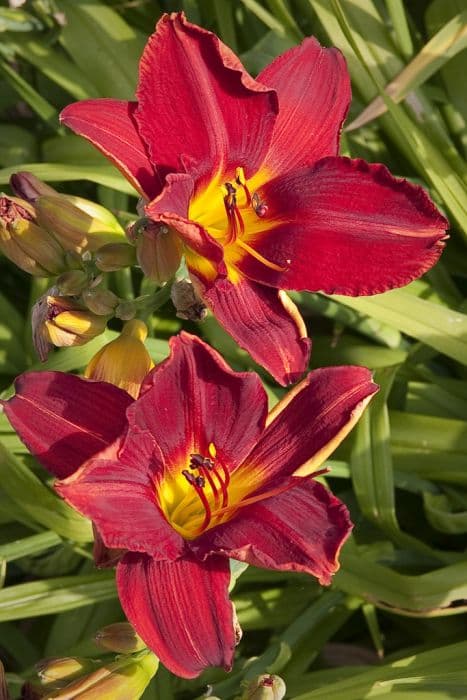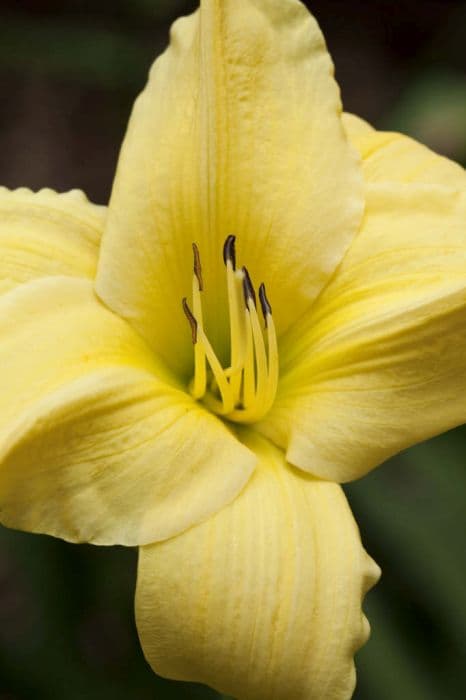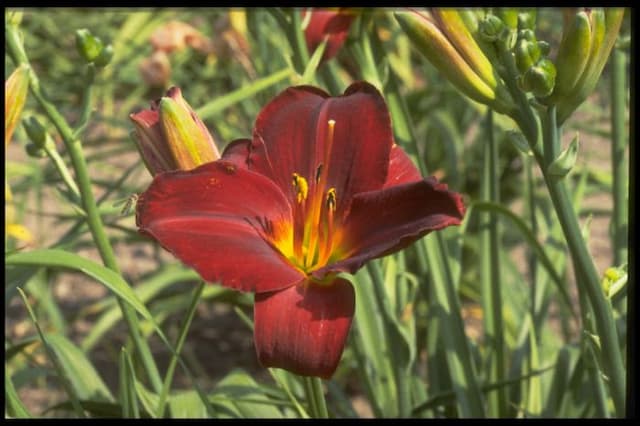Blue Flax Lily Dianella caerulea

ABOUT
The Blue Flax Lily is an evergreen perennial plant known for its attractive foliage and flowers. It has long, slender leaves that form clumps and can range in color from bluish-green to green. The texture of these leaves is typically strap-like and they can appear somewhat rigid and arching. During the flowering season, small, star-shaped flowers bloom which are usually vivid blue to purple in color. These delicate looking flowers often have prominent yellow anthers in the center, adding a striking contrast. Following the flowering season, the Blue Flax Lily can produce attractive berries. These berries are a deep, glossy blue-purple when mature and are not only visually striking but also an important food source for birds and other wildlife. The overall demeanor of the plant displays a strong, yet graceful composition that can add both color and texture to garden landscapes.
About this plant
 Names
NamesFamily
Hemerocallidaceae
Synonyms
Paroo Lily, Blue Flax Lily, Blueberry Lily, Blue Fruit Flax Lily
Common names
Dianella caerulea var. assera, Dianella caerulea var. cinerascens, Dianella caerulea var. gigantea, Dianella caerulea var. intermedia, Dianella caerulea var. producta, Dianella caerulea var. vannata, Dianella ensifolia.
 Toxicity
ToxicityTo humans
The Dianella caerulea, commonly known as the Blue Flax-lily, is not considered toxic to humans. In fact, its blue-purple berries are edible when ripe. However, the consumption of large quantities may cause discomfort or an upset stomach due to the fibrous nature of the plant. Generally, it is not associated with severe toxicity or serious consequences upon ingestion.
To pets
The Blue Flax-lily is not known to be toxic to pets. It does not contain substances that are typically harmful to pets such as dogs or cats. Therefore, the ingestion of parts of this plant is unlikely to result in poisoning or severe health issues for pets. However, as with any non-food plant, the consumption of significant amounts could potentially lead to mild gastrointestinal upset.
 Characteristics
CharacteristicsLife cycle
Perennials
Foliage type
Evergreen
Color of leaves
Green
Flower color
Blue
Height
3 feet (0.91 meters)
Spread
2 feet (0.61 meters)
Plant type
Shrub
Hardiness zones
9
Native area
Australia
Benefits
 General Benefits
General Benefits- Erosion control: Dianella caerulea has a robust root system that helps stabilize the soil, making it beneficial for preventing erosion.
- Drought tolerance: As a native Australian plant, it is well-adapted to dry conditions and requires minimal watering once established, ideal for water-conserving landscapes.
- Attracts wildlife: The flowers and berries attract a variety of wildlife, including birds and insects, contributing to local biodiversity.
- Aesthetic appeal: With its striking blue berries and delicate flowers, it adds a unique visual interest to gardens and landscaping projects.
- Low maintenance: It requires minimal upkeep beyond initial establishment, making it a convenient choice for gardeners seeking minimal maintenance plants.
- Versatility: It can be used in a variety of landscaping applications, from ground covers to border plantings or as a feature plant in pots and containers.
- Edible fruit: The berries are edible and can be used in jams and preserves, adding a functional benefit to its ornamental value.
- Shade tolerance: It can thrive in a range of light conditions, including shaded areas where other plants might struggle.
- Cultural significance: It holds cultural importance for some Indigenous Australian communities, who use it for food and other traditional uses.
 Medical Properties
Medical Properties- There is insufficient evidence available in scientific literature to establish the medical properties of Dianella caerulea, commonly known as the Blue Flax Lily.
 Air-purifying Qualities
Air-purifying QualitiesThis plant is not specifically known for air purifying qualities.
 Other Uses
Other Uses- As a natural dye: The blue-purple berries of the Dianella caerulea, commonly known as the Blue Flax Lily, can be used to create a natural dye for fabrics and materials.
- Erosion control: Due to its robust root system, the Blue Flax Lily is excellent for stabilizing soil and preventing erosion in gardens and natural areas.
- Fibre source: Indigenous Australians have traditionally used the long, strap-like leaves to make string and baskets.
- Habitat for wildlife: The thick clumps formed by the Blue Flax Lily provide shelter and breeding grounds for small animals and insects.
- Culinary decoration: The vibrant blue-purple berries can be used as a garnish to add color to culinary dishes, although they are not commonly consumed.
- Garden bordering: With its strappy leaves and attractive flowers, the Blue Flax Lily is popular for use in ornamental garden borders and edges.
- Nectar source: The small flowers offer a source of nectar for a variety of native bees and other pollinating insects.
- Recycled plant waste: Spent foliage and stems can be used as mulch or added to compost to improve soil quality over time.
- Windbreaks: When planted in groups, the Blue Flax Lily can act as a windbreak to protect more delicate plants.
- Water features: The hardy nature of this plant allows it to be used around ponds or water features where it provides a naturalistic aesthetic.
Interesting Facts
 Feng Shui
Feng ShuiThe flax lily is not used in Feng Shui practice.
 Zodiac Sign Compitability
Zodiac Sign CompitabilityThe flax lily is not used in astrology practice.
 Plant Symbolism
Plant Symbolism- Resilience: Dianella caerulea, commonly known as the Blue flax-lily, is a hardy plant that can withstand varying conditions, making it symbolic of an individual's ability to withstand challenges and recover from setbacks.
- Adaptability: With its capacity to thrive in various types of soil, the Blue flax-lily represents the ability to adapt and succeed in different environments.
- Perseverance: Since the Blue flax-lily continues to grow and spread even in tough conditions, it embodies the spirit of perseverance and the will to keep going regardless of obstacles.
 Water
WaterThe Blue Flax Lily should be watered thoroughly, ensuring the soil is moist but not waterlogged. During the growing season, water the plant every week with approximately 1 gallon per plant, adjusting for rainfall and temperature conditions. In the winter months, reduce watering to every other week, making sure the soil does not dry out completely. If the plant is in a pot with drainage holes, water until excess moisture runs out, indicating the soil is fully saturated. Always check the top inch of soil for dryness before watering again to prevent overwatering.
 Light
LightThe Blue Flax Lily thrives in full sun to partial shade conditions. The ideal spot is where the plant will receive at least four to six hours of sunlight daily. It can tolerate a range of light conditions, but too much shade might reduce flowering and cause the plant to become leggy. For best results, place it in a location that receives morning sunlight and dappled afternoon shade, especially in regions with hot summers.
 Temperature
TemperatureThe Blue Flax Lily is hardy in temperatures ranging from 25°F to 100°F, but it grows best when the temperature is consistently between 60°F and 85°F. Protect the plant from frost, as it can be damaged by severe cold. It prefers a moderate climate and may require protection or mulching in colder areas during the winter months.
 Pruning
PruningPrune the Blue Flax Lily to remove dead or damaged foliage and to maintain a tidy appearance. Pruning is best done in late winter or early spring before new growth begins. This plant does not require frequent pruning; however, cutting back the foliage every couple of years can help rejuvenate the plant and encourage denser growth. Remove spent flower stems after flowering to encourage additional blooms.
 Cleaning
CleaningAs needed
 Soil
SoilFor Blue Flax Lily, a well-draining soil mix that includes loam, sand, and peat with some organic matter is ideal. The pH should be slightly acidic to neutral, ranging between 5.5 to 7.0.
 Repotting
RepottingBlue Flax Lily should be repotted every 2 to 3 years or when rootbound to ensure healthy growth and sufficient space for root expansion.
 Humidity & Misting
Humidity & MistingBlue Flax Lily thrives best in moderate to high humidity levels but is quite adaptable and can tolerate less humid conditions typically found in home environments.
 Suitable locations
Suitable locationsIndoor
Place Blue Flax Lily in bright, indirect light and ensure good air circulation.
Outdoor
Plant Blue Flax Lily in partial shade with well-draining soil.
Hardiness zone
8-11 USDA
 Life cycle
Life cycleThe life of Dianella caerulea, commonly known as the Blue Flax Lily, begins with seed germination, a process which may be enhanced by exposure to smoke or fire, mimicking natural bushfire conditions. Once germinated, the seed develops into a seedling with grass-like foliage, establishing a strong root system. As it matures, the plant forms clumps of strappy, green leaves and eventually sends up flowering stems bearing clusters of small, star-shaped blue-purple flowers, typically during spring and summer. After pollination, often by insects, the flowers develop into small, shiny, dark blue berries. Each berry contains seeds that can be dispersed by birds and other animals, which eat the fruit and excrete the seeds into new locations. The Blue Flax Lily is a perennial plant, capable of surviving and flowering for many years, and it can also spread by rhizomes to form larger clumps over time.
 Propogation
PropogationPropogation time
Spring-Early Summer
Propogation: The most popular method of propagating the plant commonly known as Blue Flax Lily is by division. This is often done in late winter to early spring when the plant is less actively growing. To propagate by division, gardeners carefully dig up the Blue Flax Lily, preserving as much of the root system as possible. They then separate the clumps into smaller sections, ensuring each has a portion of the roots. These sections are immediately replanted in well-draining soil at the same depth they were previously growing. Water the newly planted divisions thoroughly to help establish them. This technique utilizes the plant's natural tendency to spread and is very effective for expanding the garden or creating new plantings.









